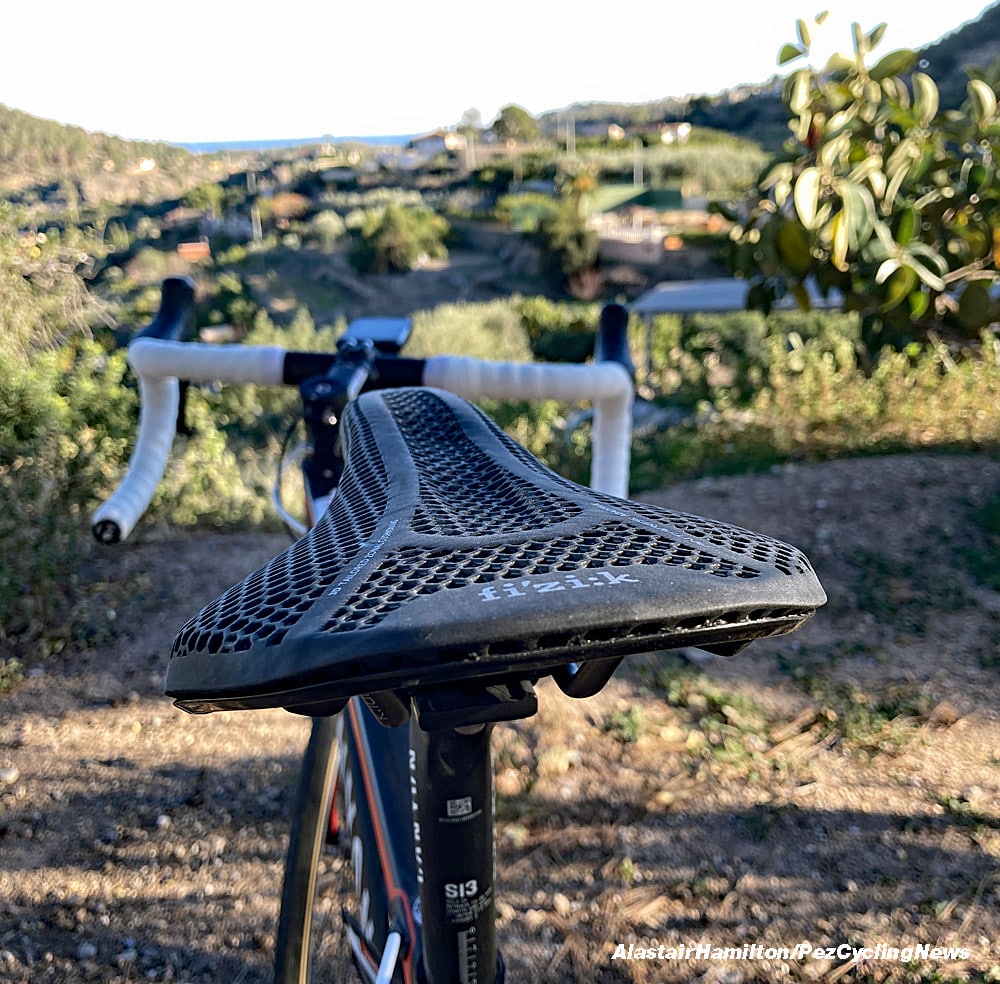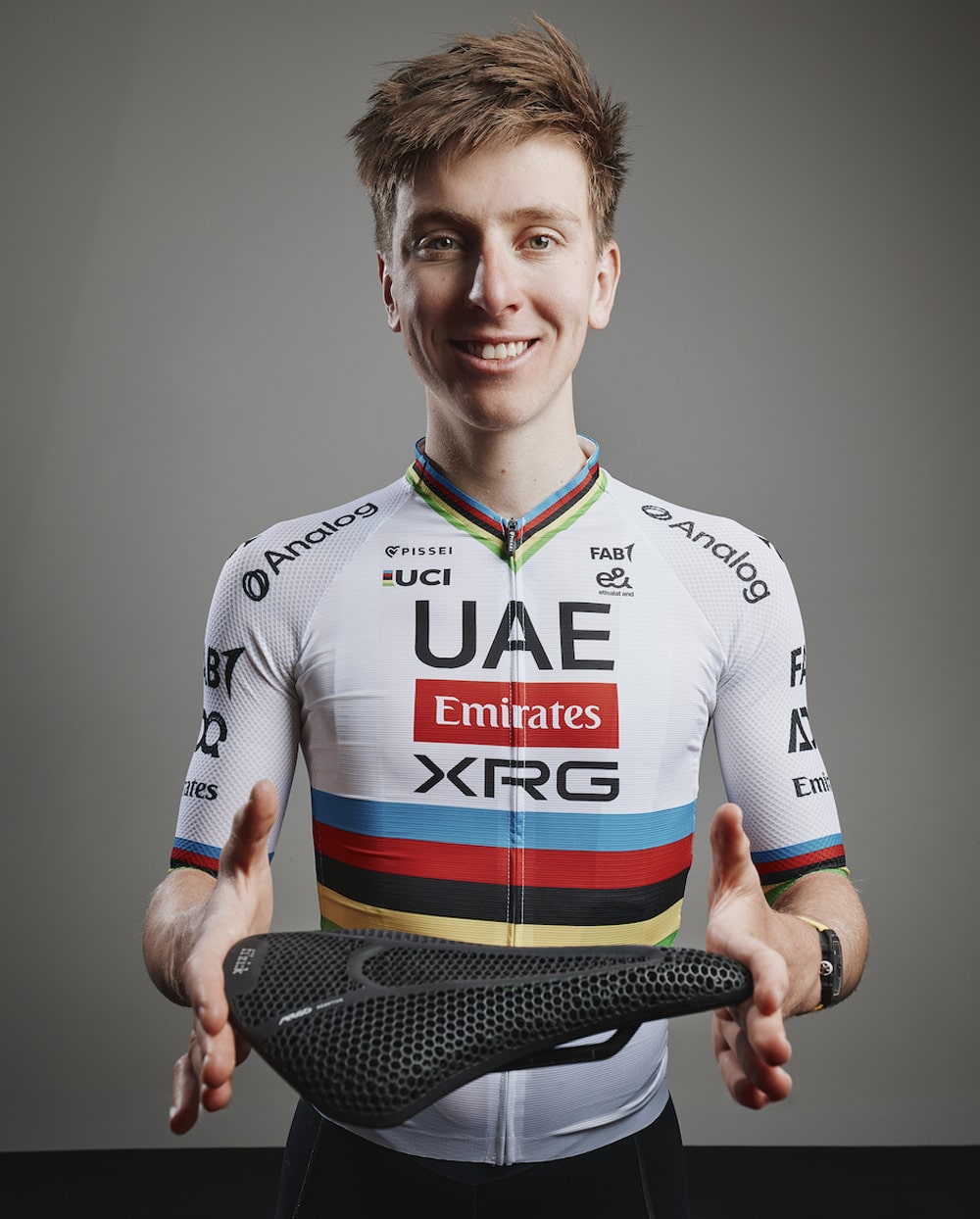fizik Vento Antares R3 Adaptive 3D-Printed Saddle Review
The fizik Vento Antares R3 Adaptive 3D-printed saddle is versatile and designed with a low-profile, tapered nose-to-wing transition, and Adaptive 3D-printed padding to provide comfort in every riding position. Our man in Spain, Alastair Hamilton, recently had the chance to put the Vento Antares through its paces… What does he think?

Alastair Hamilton PEZ sez: Fifty years ago I had a Brooks leather saddle on a borrowed Carlton race bike, from there I went on to a Cinelli Unicanitor saddle, which had a little bit of padding. Saddles have changed a lot since then and now we have 3D-printed saddles. What next?

I’ve mostly been riding Selle Italia saddles and apart for trying a fizik Aliante about 20 years ago, I’ve stuck to what I know suits me. The thought of using something different was a bit daunting. Measuring the Antares, the dimensions are very similar to the Selle Italia SLR, slightly longer and about the same length as the Flite. So maybe nothing to worry about… Let’s find out. I had to make one adjustment, I had set the distance from the nose of the saddle to the centre of the handle bars, the same as the SLR, but it felt too far back. I moved it forward by about a centimetre, which felt just right. When remeasuring, the distance from the back of the fizik Antares to the centre of the bars was the same as the measurement from the back of the SLR.

The Zwift saddle test
All the technical details you can read bellow, what you want to know from me, ‘was it comfortable?’ The first two rides were on Zwift (other platforms are available), as this must be the best test for a saddle. You spend most of the time sat down and you do put a lot of pressure on ‘that part’ of your body when home training. Plus you can concentrate on the feeling without any road distractions. Yes, it is comfortable and the extra length allows you to move around a bit more, which is nice. I found I was more on the sit bones than on other saddles, and felt like I was pushing back against something. There was no pressure on the ‘family jewels’ and there was no rubbing, chaffing or pressure in the centre part of the saddle. So all good.

Obviously the 3D-printed padding is the big difference for other saddles. The centre section is fairly soft to protect the prostate area, as are the ‘wings’, the widest part of the saddle, which gives comfort to the back of the thigh at the bottom of the down-stroke. The hardest part of the saddle is at the sit bone area, with a medium hardness either side of the soft centre and at the nose. The shell is solid with a bit of ‘give’ in the centre, the lightweight rails are joined perfectly to the base, all very well manufactured. I weighed it in at 226g, but my scales are usually around 4/5g heavy, so fizik’s 220g is probably about right.

220g would be about right
Out on the road, in the real world, the saddle performed just as well. I’ve only managed to get out for just under two hours and there was no discomfort and all felt good. No complaints. This not the first 3D-printed saddle I’ve ridden and the technology is probably going to work its way down the price range and we will see 3D saddles at the lower level, eventually. It does feel different, comfortable yes, but the surface of the saddle isn’t smooth. This didn’t bother me and with good quality shorts you might not even notice, you maybe don’t move around as much which suits some people, but maybe not everyone. On the whole, the fizik Vento Antares R3 Adaptive 3D-printed saddle is a top of the range saddle with the comfort and padding in all the right places. It’s what you want/need from a saddle.

And now Tadej Pogačar has joined me and is riding a fizik 3D printed saddle this year.

What fizik say: A high-performance saddle with a streamlined shape and tapered nose-to-wing transition, now available with Adaptive padding, our most advanced 3D-printed padding technology.

The Future of Performance
Part of a new generation of Antares saddles, the Antares R3 Adaptive maintains many iconic design features that have long made the original so popular amongst leading athletes. First introduced over twenty years ago, Antares has appeared in nearly every Grand Tour since. Reimagined in our innovative Adaptive padding, Antares is ready to make history again. Delivering performance and comfort, from road to CX and XC, the Antares R3 balances strength and weight savings with a carbon-reinforced nylon shell and Kium hollow rail combo.

3D-Printed Padding
Fizik Adaptive 3D-printed padding has expanded to the Antares family, creating the perfect match for those who want exceptional, long-lasting comfort on a low-profile performance saddle designed to allow a more connected feeling for optimal pedalling efficiency and power transfer.

Tailored Zonal Cushioning
The evolution of digital 3D printing has allowed us to develop a new saddle without the constraints or limitations imposed by traditional production methods and materials. The Adaptive saddle padding is crafted by Carbon® using their revolutionary Digital Light Synthesis™ technology. DLS is an additive manufacturing process which uses digital ultraviolet light projection, oxygen permeable optics, and programmable liquid resins to produce parts with excellent mechanical properties, resolution, and surface finish.

Lab Tested, Road Proven
Using Carbon® technology, biomechanics and engineers have an unprecedented possibility: to design and manufacture multiple functional zones within the saddle, tuning each of them separately for specific mechanical properties. Each of these key functional zones is engineered for a distinctive cushioning and mechanical response, joined together progressively and seamlessly in the same padding. The result? A 60% reduction in peak pressure through improved weight distribution for increased comfort across the entire saddle surface.

Power Transfer & Pressure Relief
Antares is a low-profile saddle with a tapered transition from nose to wing that helps riders deliver efficient pedalling in every riding position. 3D-printed padding provides a responsive, race-ready feeling to better connect rider and bike. Through this technology, we are able to incorporate a softer central zone instead of a traditional cut-out to provide better pressure relief without sacrificing performance. No matter if you’re attacking a climb or holding the tempo on flat terrain, Antares R3 Adaptive is designed to support you.

Check the fizik website for your area for price.
Technologies/Specifications
- ADAPTIVE: Carbon® Digital Light Synthesis™ 3D-printing technology, offering seamlessly engineered zonal cushioning
- ANTARES: Low-profile performance saddle designed to allow a more connected feeling for optimal pedalling efficiency and power transfer
- R3: Combination of a ride-compliant, carbon-reinforced nylon shell and a Kium hollow rail with a high strength-to-weight ratio
Antares Adaptive R3 140mm
- Length: 268mm
- Width: 140mm
- Height at 75mm width: 50mm
- Length from nose to 75mm width: 147mm
- Weight: 220g
- Rail: 7x7mm
Antares Adaptive R3 150mm
- Length: 268mm
- Width: 150mm
- Height at 75mm width: 50mm
- Length from nose to 75mm width: 147mm
- Weight: 225g
- Rail: 7x7mm
- More info at: www.fizik.com .



Comments are closed.